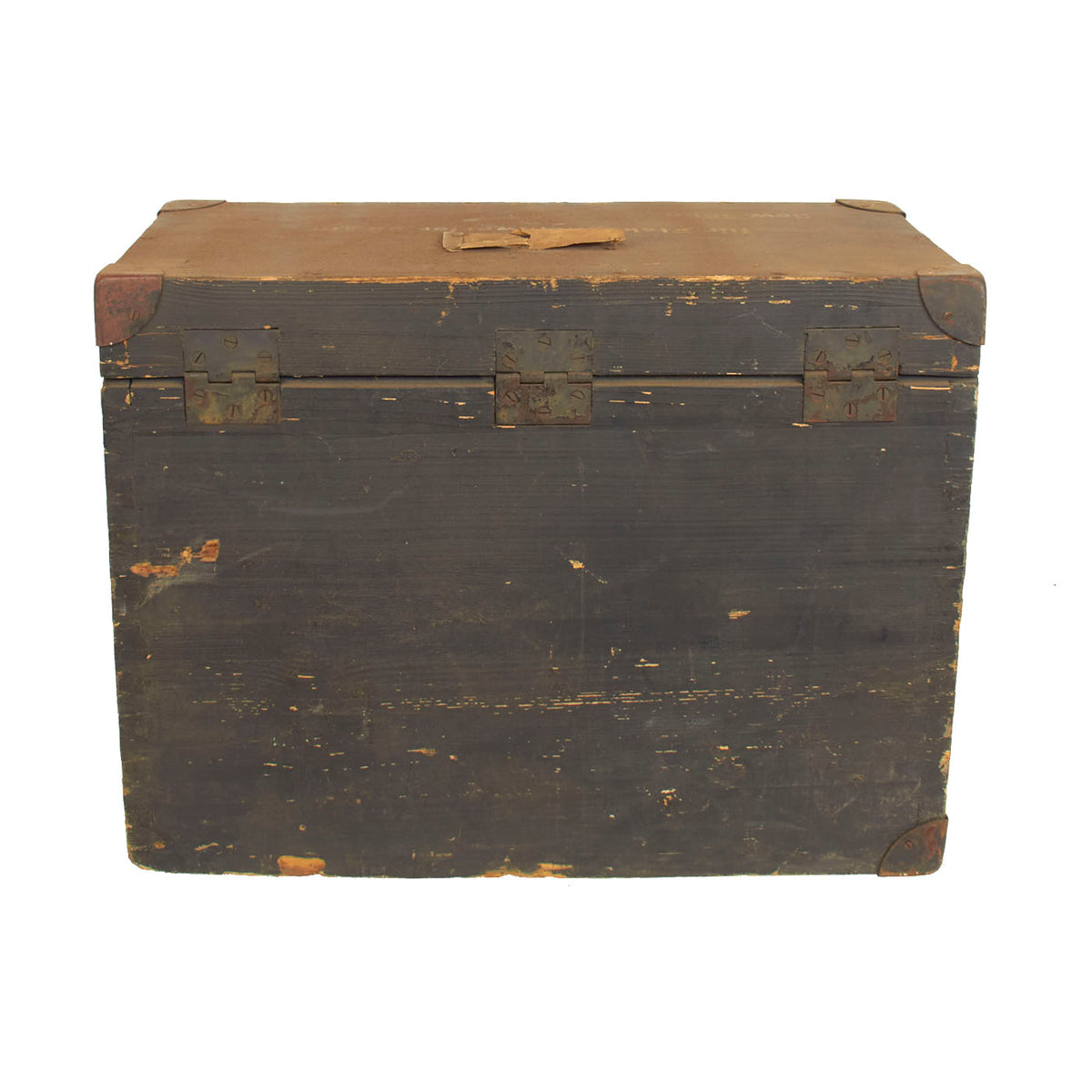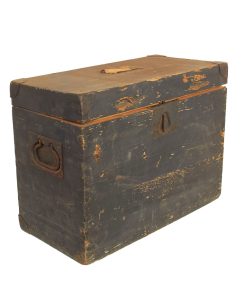Original German WWII Flakscheinwerfer 36 60cm Anti-Airfraft Searchlight Wooden Transit Crate for Parts & Spares Original Items
$ 195,00 $ 78,00
Original Item: Only One Available. This is a very nice service used condition original parts and spares wooden transit crate for use with the German WWII Flakscheinwerfer 36 60cm Anti-Aircraft Spotlight. It is clearly marked für Flakscheinwerfer 60cm on the top, and indicates that loaded it would weigh about 38kg. There are some labels on the box, but they are completely faded, so we are unable to determine exactly which parts would have been stored inside.
It measures approximately 22″ x 17″ x 11, and looks to possibly have been designed for some type of rack to fit inside. It may have been for pieces to the front louvers, or possibly for electronic components, of which the spotlights had many. They also had generators to provide power as well. We have not been able to find a similar crate before, and the size makes it perfect for storing other items, so most likely few survived until this day.
A very nice original German WWII Transit Crate, ready to research and display!
German searchlights of the Second World War were used to detect and track enemy aircraft at night. They were used in three main sizes, 60, 150 and 200 centimeters. After the end of the First World War, German development of searchlights was effectively stopped by the Treaty of Versailles, it resumed in 1927. At the outset of the war, searchlights were combined with acoustic direction-finders, with the direction-finders guiding the searchlights to the right part of the sky, where they swept until they found the target. Later in the war, the searchlights were radar-directed. The searchlights used extremely high-powered Carbon Arc lamps.
60cm Searchlights were developed in the late 1930s, with a 60 centimetres (24 in) diameter parabolic glass reflector and was powered by an 8 kilowatt generator. The lamp output was rated at 135 million candelas, and it had a detection range of about 5 kilometres (3.1 mi) for targets travelling at an altitude of 1,500 metres (4,900 ft). With the beam dispersed, this reduced to about 3.2 kilometres (2.0 mi). It required a crew of three and could be transported using a single axle Special trailer 51. One of the crew operated the searchlight, another operated the generator, and the third was the section commander. Naval versions of the searchlight included a shutter, to allow them to be used for Morse signaling.
The searchlight was controlled in azimuth and altitude by two, hand-operated cranks. The searchlight operator also had a foot-switch that operated a lamp on the generator. He could use this to send simple Morse signals to the generator operator, requesting, for example, more or less power. The searchlight included a sophisticated system to control the carbon arc lamp, extending the carbon electrodes to keep a constant arc distance as the ends of the electrodes burned away.
The 8 kilowatt, direct current generator that powered the searchlight was driven by a six-cylinder, BMW engine, of a type used in pre-war cars.
Typical tactics were to sweep the search light in an S-shaped pattern along the targets’ expected course with the beam dispersed, once the target was detected, it was then tracked using the focused beam.
The 60 cm searchlights were not powerful enough to reach the allied bomber streams later in the war, so were typically employed organically with 20 mm and 37 mm low-level flak guns.
Fast Shipping with Professional Packaging
Thanks to our longstanding association with UPS FedEx DHL, and other major international carriers, we are able to provide a range of shipping options. Our warehouse staff is expertly trained and will wrap your products according to our exact and precise specifications. Prior to shipping, your goods will be thoroughly examined and securely secured. We ship to thousands clients each day across multiple countries. This shows how we're dedicated to be the largest retailer on the internet. Warehouses and distribution centres can be located throughout Europe as well as the USA.
Note: Orders with more than one item will be assigned a processing date depending on the item.
Before shipping before shipping, we'll conduct a thorough inspection of the items you have ordered. Today, the majority of orders will be delivered within 48 hours. The delivery time will be between 3-7 days.
Returns
The stock is dynamic and we cannot completely manage it because multiple stakeholders are involved, including our factory and warehouse. So the actual stock may alter at any time. It's possible that you may not receive your order once the order has been made.
Our policy is valid for a period of 30 days. If you don't receive the product within 30 days, we are not able to issue a refund or an exchange.
You can only return an item if it is unused and in the same state as the day you received it. You must have the item in its original packaging.
Related products
Uncategorized
Uncategorized
Uncategorized
Uncategorized
Uncategorized
Uncategorized
Uncategorized
Uncategorized
Uncategorized
Armored Burgonet Helmet & Polearm from Scottish Castle Leith Hall Circa 1700 Original Items
Uncategorized
Angolan Rebel 1970s era 60mm Inert Display Mortar from Angolan Civil War Original Items
Uncategorized
Uncategorized
Uncategorized
Uncategorized
Uncategorized
Uncategorized
Uncategorized
Uncategorized
Uncategorized













































































